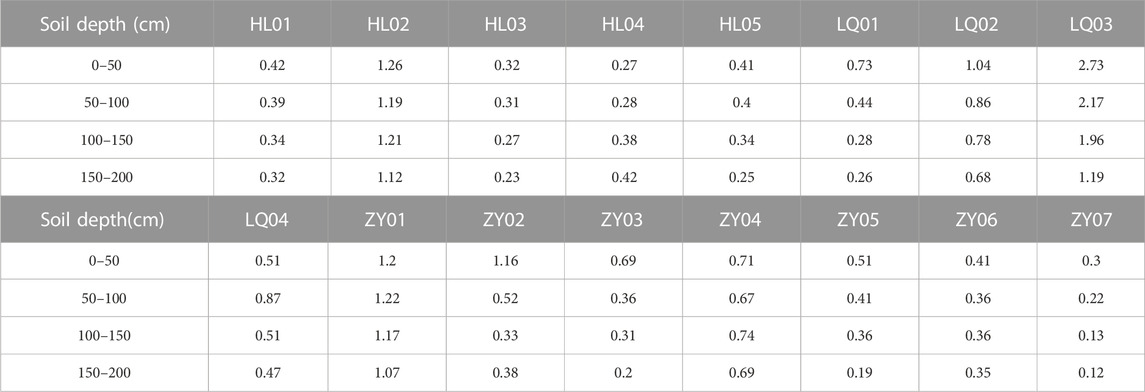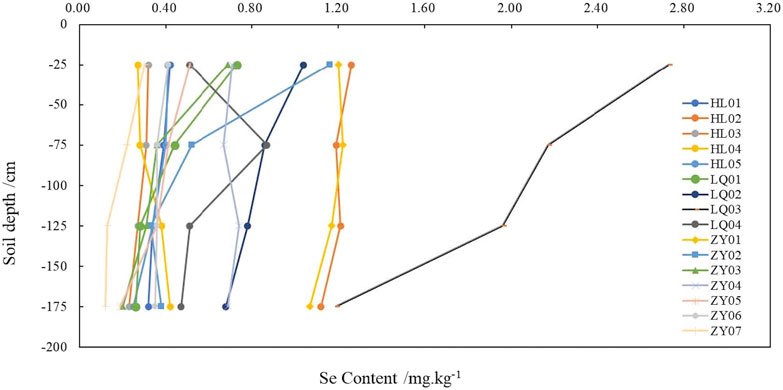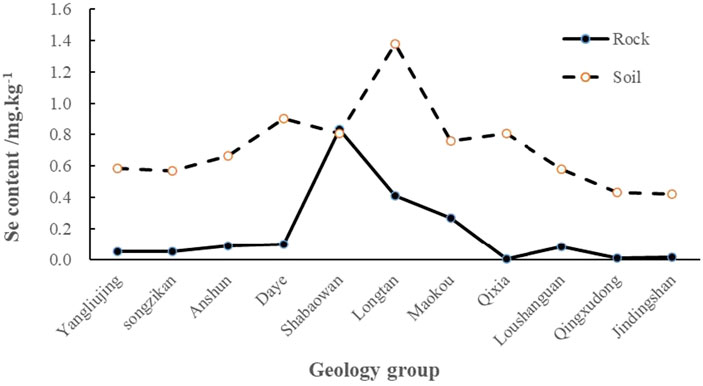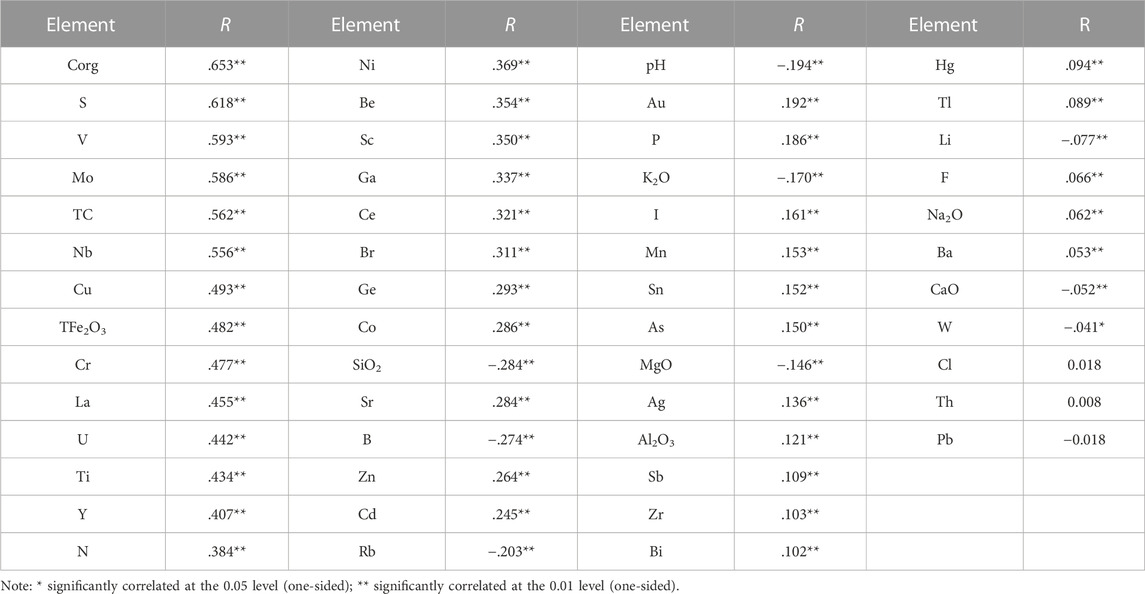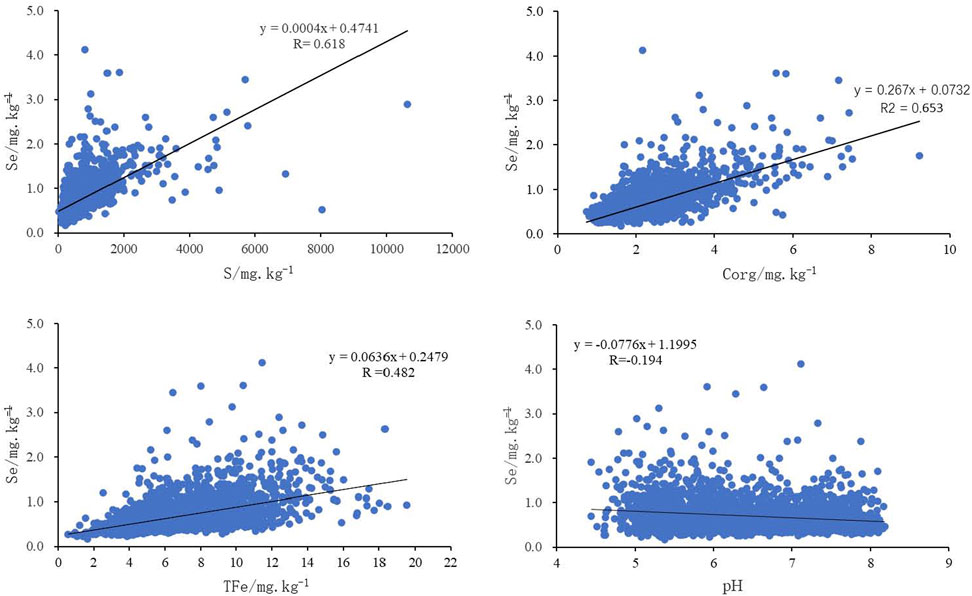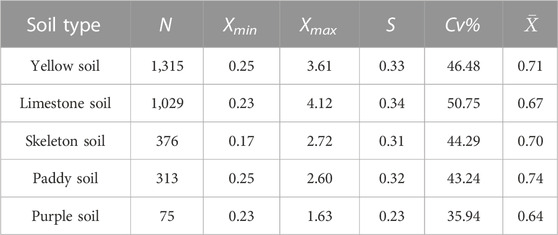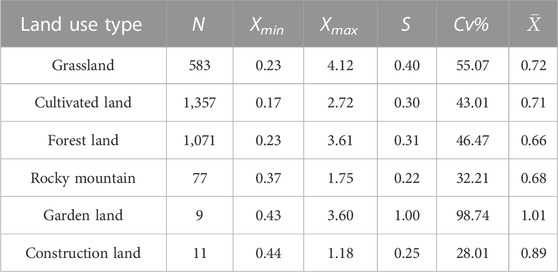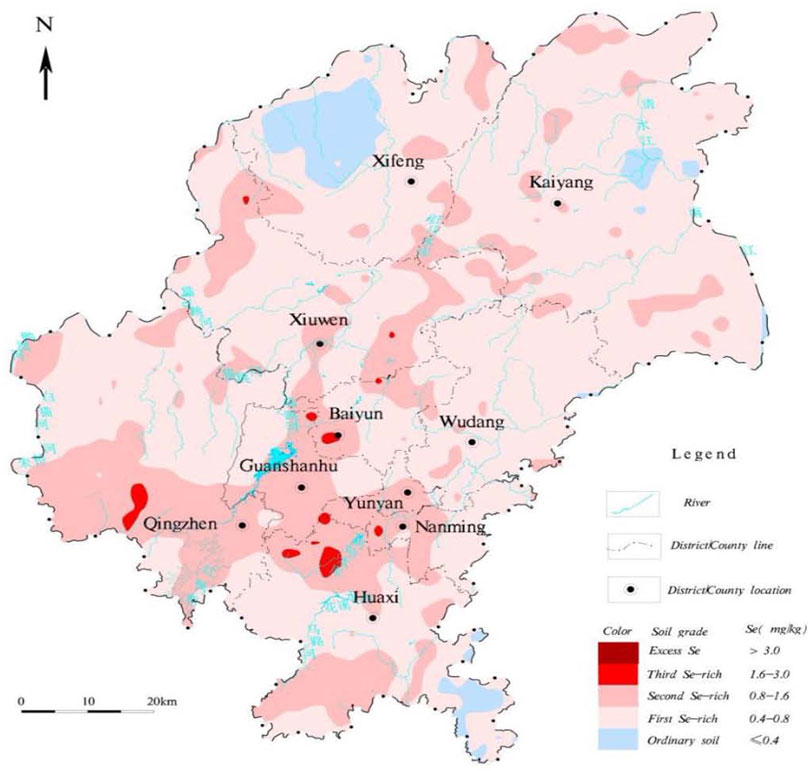- 1Moutai Institute, Renhuai, China
- 2Guizhou Academy of Geological Survey, Guiyang, China
- 3Central Laboratory of Geology and Mineral Resources of Guizhou Province, Guiyang, China
Selenium concentration in soil is of great importance for the production of selenium-rich crops. In this article, we studied the geochemical characteristics of soil selenium and evaluated selenium-rich land resources in the Guiyang city area using results from a Guizhou multi-purpose regional geochemical survey. The results indicate that 1) the selenium content in topsoil in the Guiyang area ranges from 0.11 to 4.12 mg kg−1, with an average value of 0.70 mg kg−1, which is 2.4 times and 3.5 times the national and world soil background values, respectively, while the selenium content in deep soil ranges from 0.11 to 4.10 mg kg−1, with an average value of 0.42 mg kg−1, which is 1.4 and 2.1 times the national and world soil background values, respectively; in the vertical profile, the selenium content in soil decreases with the increase in soil depth. 2) The main factors affecting the distribution of selenium in soil include soil parent material, soil physical and chemical properties, and other components, such as soil type and land use, among which the soil parent material (rock) plays a decisive role. The selenium in soil mainly comes from the soil parent rock, increasing accordingly with the increase of the selenium background value of the parent rock; the physical and chemical properties of the soil and other components impose certain influences on the selenium content. Selenium presents a significant linear positive correlation with sulfur and organic carbon, while it has a negative correlation with the pH value; there is no significant difference in the selenium content in different soil types, following the distribution order of paddy soil >yellow soil> skeletal soil> lime soil> purple soil; land use has a certain effect on selenium in soil, following the distribution order of garden land > construction land > grassland > farmland > rocky hills > forest land. 3) The area of selenium-enriched soil in the study region is 11,408 km2, with 91.76% of selenium-enriched soil and 8.24% of general soil or extremely little excess-selenium soil. Therefore, the vast majority of soil in Guiyang is selenium-enriched. The city has large and abundant selenium-enriched areas, which are domestically and internationally rare and provides particularly favorable resource conditions for developing selenium-enriched efficient mountain agriculture to expedite rural revitalization.
1 Introduction
Selenium (Se) is a typical, dispersed element with a low abundance of 0.05–0.09 mg kg −1 in the Earth’s crust (Liu et al., 1984). However, it is one of the essential trace elements for humans and animals (Mao et al., 2016; Dinh et al., 2018; El-Ramady et al., 2020; Szarka et al., 2020), contributing to improving the immune function of animals (Ben et al., 2011), showing obvious antagonistic effects (Jarzyńska et al., 2011) on the toxicity of heavy metals such as cadmium, arsenic, mercury, and silver and enhancing human anti-cancer and anti-aging abilities (Heath et al., 2010; Kolachi et al., 2011). Selenium deficiency may cause various diseases, such as white muscle disease, Keshan disease, and Kashin–Beck disease, in humans and animals (Tan J, 1996; Zhang et al., 1990). However, excessive intake of selenium will also impose toxic effects on humans and animals, causing human lipsotrichia, diabetes, and staggering disease in animals (Xue et al., 2011; Wang et al., 2020; Ellis, Salt, 2003; Thomson, 2004; Ben et al., 2011). The main source of selenium for the human body is food (Hu Y et al., 2010), and soil is the reservoir where the selenium in our food comes from, playing a decisive role in the content of Se in food, vegetables, and even drinking water (Tan et al., 2002; Ellis, Salt, 2003; Li et al., 2012; Qin et al., 2013). Therefore, the abundance of Se in the soil directly affects the content of Se in the food, ultimately affecting the health of humans and animals. China has a deficiency of Se in large areas, with more than 10 provinces and autonomous regions showing varying degrees of Se deficiency. Se-deficient areas account for approximately 51% of the total land area in China (Dinh et al., 2018). High-selenium rocks such as Permian coal-measure strata and Cambrian black shale are widely distributed in Guizhou Province, laying a certain material foundation for selenium enrichment in the soil. Many previous studies based on different survey methods found that the average soil Se contents in Guizhou Province, such as 0.37, 0.39, and 0.48 mg kg−1 from He (1996), Wang (2003), and Cai (2021), respectively, were all higher than those of the national and world average. Most of the areas are selenium-moderate areas, and there are some selenium-deficient and selenium-rich areas. The studies provide basic data for further investigation, research, and exploitation of selenium-enriched land resources. At present, there are few investigations and studies on regional and local soil selenium distribution characteristics and selenium-enriched land resources. Only a few scholars have carried out research studies on the selenium enrichment levels of soils and related crops in Kaiyang, Fenggang, and the central district of Guiyang (Li, 2004; Lian, 2011; Liu, 2012; Pan, 2017). However, there are currently no reports on selenium in the soil of the Guiyang area, which has been thoroughly studied yet. The primary objective of this study is to investigate and evaluate the geochemical characteristics of selenium in soils and selenium-enriched land resources of the Guiyang area based on the results of multi-purpose regional geochemical surveys in Guizhou Province. Thus, our results can provide a scientific basis for the efficient utilization of land resources and construction of a selenium-enriched agricultural production base, support rural revitalization, and serve the national policy of the big ecology strategy.
2 Materials and methods
2.1 Study area
Guiyang, located in the hinterland of southwest China, the eastern part of the Yunnan–Guizhou Plateau, the middle section of the Miaoling Mountains of the Yunnan–Guizhou Plateau, and the watershed of the Yangtze River system and Pearl River system, is one of the most important cities in Southwest China. The geographical coordinates of the working area are 106°04'21"–107°15'37” east longitude, and 26°10'22"–27°29'10" north latitude, covering an area of about 10,000 km2, including six urban districts, i.e., Nanming, Yunyan, Guanshan Lake, Baiyun, Huaxi, and Wudang, as well as four suburban counties (cities), i.e., Xifeng, Xiuwen, Kaiyang, and Qingzhen.
Guiyang is located in the middle of the mountain plateau and hills of the central area of Guizhou and the watershed of the Yangtze River system and Pearl River system, presenting a general topography as high in the southwest and low in the northeast. The landform falls into the category of a hilly basin area dominated by mountains and hills. Mountains and hills account for more than 80% of the area, with few dams. In addition, there are a few canyons and other landforms.
The study area is located in the first-level tectonic unit—the Yangtze Block of the South China Plate. The northern part belongs to the fourth-level tectonic unit—the complex tectonic deformation area in Guiyang; the southern part belongs to the fourth-level tectonic unit—the tectonic deformation area in the north and south of Guiyang. The strata in the area are relatively well developed, with exposures from the Cambrian to the Quaternary strata, and the accumulated maximum thickness is about 10,000 m. Among them, the Triassic system is most widely distributed, accounting for about 50% of the area, followed by the Permian and Cambrian strata, and the rest of the strata are mostly scattered. The rock types are mainly neritic platform carbonate rocks, and a very small part is the terrestrial fluvial and lacustrine red rock series.
The soil types are closely related to the carbonate parent rock. Given the small size of our study area and the small number of soil types covered, we classified the soil types in this region according to the classification standard of GBT17296-2009 classification and codes for Chinese soil, resulting in four major types of yellow soil, lime soil, paddy soil, and purple soil, accounting for 30.66%, 53.42%, 14.30%, and 1.07% of the total soil area of the city, respectively. Among them, the lime soil is mainly muddy and sandy muddy lime soil; the yellow soil is mainly ferrosilicon yellow soil. Land resources are mainly used as agricultural land (including grassland, farmland, and forest land), followed by construction land and unused land, as well as some water areas and special land.
2.2 Sample collection
2.2.1 Soil samples
According to the requirements of the Specification of Multi-Purpose Regional Geochemical Survey (1:250,000) (China geological survey, 2005), the surface and deep soil samples were collected by the double-layered grid. The sampling density of topsoil was 1 pc/km2, with a sampling depth of 0–20 cm. Soil samples were collected from more than five appropriate sites at an equal proportion within a radius of 50 m in the sampling grid. The sample weight was ≥1,000 g. The sampling density of deep soil was 1 pc/4 km2. Soil columns within a depth of 150–200 cm were collected using a twist drill. The sample weight was ≥1,000 g. Considering the representative uniformity and control, the sampling sites were generally located in paddy fields, dry land, garden land, and forest land to avoid man-made pollution and recent accumulations of soil. The samples were dried naturally and passed through a 20-mesh sieve. The topsoil samples collected from four sites within 4 km2 were equally combined to form one analytical sample, and the deep soil samples collected from four sites within 16 km2 were equally combined to form one analytical sample. A total of 12,432 topsoil samples were collected in the whole area, forming 3,108 combined analytical samples, and 3,108 deep soil samples were collected, forming 777 analytical samples.
2.2.2 Rock and crop samples
The areas abnormally enriched with selenium were selected for the investigation of rock geochemistry, vertical soil profiles, and selenium enrichment of crops. Collection method of rock samples: Areas with the complete exposure of stratigraphic units and bedrock were selected. Rock profiles were allocated in the vertical direction to the direction of the strata. The rock sampling sites were kept in a spacing of 2–∼500 m. Taking the stratum as a unit, 2–3 samples were collected in each unit, and the sample mass was ≥500 g. Collection method of soil vertical profile samples: Samples were collected at a spacing of 50 cm within a depth range of 0–200 cm using a twist drill. The sample weight was ≥1,000 g. The collection method of plant (crop) samples was taken in accordance with the requirements of Technical Requirements for Regional Eco-geochemical Evaluation (Trial) (DD2005-03) (China geological survey, 2005).
2.3 Sample analysis and quality control
The sample analyses were completed at the Nanjing Mineral Resources Supervision and Testing Center of the Ministry of Land and Resources. The soil samples were analyzed for 54 elements/indicators to explore their content and distribution in relation to that of selenium in soils using the following methods: determination of SiO2, Al2O3, Fe2O3, K2O, Ba, Br, Cl, Cr, Cu, Ga, Mn, Nb, Ni, P, Pb, Rb, S, Sr, Ti, V, Y, Zn, and Zr and certain Na2O, MgO, and CaO by X-ray fluorescence (XRF); determination of Be, Bi, Cd, Ce, Co, La, Li, Mo, Sc, Th, Tl, U, and W by inductively coupled plasma mass spectrometry (acid-soluble ICP-MS); determination of As, Hg, Se, Sb, and Bi by atomic fluorescence spectroscopy (AFS); determination of Ag, B, and Sn by optical emission spectrometry (OES); determination of Au by flameless graphite furnace atomic absorption spectrometry (GFAAS); determination of Ge and I by inductively coupled plasma mass spectrometry (alkali-soluble ICP-MS); determination of F by the ion-selective electrode (ISE); determination of N by the potassium dichromate–sulfuric acid digestion distillation volumetric method; determination of C by tube furnace combustion non-aqueous titration; determination of Corg by the potassium dichromate volumetric method; and determination of the pH value by the potentiometric method and using the pH meter.
To ensure the reliability of the data analysis results, we strictly controlled the quality of the analysis process according to the requirements of the multi-purpose regional geochemical survey specifications, and the accuracy and precision were controlled with the national-level soil standard materials (GBW series). The sampling and analysis errors were analyzed by more than 2% and more than 3% for multi-duplicated samples. They were randomly checked for the quality of abnormal point monitoring and analysis. The analysis of rock and crop samples was carried out in accordance with the relevant regulations of Specification of Multi-Purpose Regional Geochemical Survey (1:250,000) and Technical Requirements for Analysis of Eco-geochemical Evaluation Samples.
2.4 Data processing and mapping
We used EXCEL to compute the geochemical parameters of the soil selenium content, such as their minimum, maximum, and mean values. Then, we analyzed the correlation between selenium and other components by SPSS software and produced the geochemical evaluation map of selenium-rich land resources using GeoMDIS (multipurpose) and MapGIS 6.7.
3 Results and discussion
3.1 Distribution characteristics of selenium in soil
3.1.1 Geochemical distribution characteristics of Se in surface and deep soil
According to the statistics of the analysis results of the selenium contents in surface and deep soil in the Guiyang area, the geochemical parameters of selenium were obtained (Table 1). The selenium contents of topsoil in the Guiyang area ranged from 0.17 to 4.12 mg kg−1, with an average of 0.70 mg kg−1, which were 2.4 and 3.5 times the national and world soil background values (Lisk, 1972; China environmental monitoring center, 1990), respectively. The selenium contents in the deep soil ranged from 0.11 to 4.10 mg kg−1, with an average of 0.42 mg kg−1, which were 1.4 and 2.1 times the national and world soil background values, respectively. The coefficients of variation of selenium in the surface and deep soil were 47.1% and 66.7%, respectively, indicating that the selenium in the soil did not fluctuate much.
3.1.2 Distribution characteristics of Se in vertical soil profiles
Generally, soil comprises layered characteristics; minerals and elements of different soil layers have different content characteristics. In order to study the distribution rule of Se in soil at different depths, 16 vertical soil profiles were arranged in three geochemical anomaly areas: Zhuchang–Yanshenhong (ZY) in Baiyun District, Huali–Longshui (HL) in Kaiyang county, and Liwo–Qibo (LQ) in Qingzhen city, and soil samples were collected from top to bottom every 50 cm within a depth of 0–200 cm. The results of sample analysis are shown in Table 2, and the distribution of Se in vertical soil profiles is shown in Figure 1. From Table 2 and Figure 1, it has been seen that the distribution law of Se in most soil profiles (except for HL02, HL04, ZY01, and ZY04) is as follows: surface layer>middle upper layer>middle lower layer>deep layer. The Se content in the soil decreased with the increasing soil depth. The Se content in the surface soil in the LQ01, LQ03, ZY02, ZY03, ZY05, and ZY07 was over twice that in the deep soil, suggesting Se was more enriched in the surface soil. The following are possible reasons for Se enrichment in the surface soil: 1) the surface soil was rich in Fe, Al, peat, and humus (Li et al., 2000), which exerted some adsorptive effect on Se. Moreover, when the soil solution was acidic, Se was easy to bind to or absorb on the soil humus so that it rarely dissolved, migrated, and leached away. 2) The Se content in the surface soil was generally higher than that in soil parent materials. On one hand, this is a reflection of secondary Se enrichment in the soil-forming process; on the other hand, this might be the result of exogenous Se input (e.g., atmospheric sedimentation, irrigation, fertilization, etc.).
3.2 Influencing factors for the selenium content in soil
The main factors affecting selenium in the soil include soil parent material, soil physicochemical properties, soil types, and land utilization types, which are discussed in the following sections.
3.2.1 Influence of soil parent rocks on selenium in soil
Soil is formed by the weathering of rocks. The selenium in soil depends, to a large extent, on selenium in the parent rocks (Zhang et al., 2002). Two rock profiles were set up in the Zhuchang–Yanshanhong and Shuangliu–Baima anomalous areas. Rocks and corresponding soil samples from different stratigraphic units were both collected for analysis and research. The results are listed in Table 3, and Figure 2 shows the comparison of selenium contents in rocks and soils of different geological units. It can be seen from Table 3 and Figure 2 that the Se content of rock and soil in different geological units is both uneven, sorted as follows in rocks, Shabaowan > Longtan > Maokou > Daye > Anshun > Yangliujing > Songzikan, while as follows in soil, Longtan > Daye > Shabaowan > Maokou > Daye > Anshun > Loushanguan > Yangliujing > Songzikan > Jindingshan > Qingxudong > Qixia. Except for Shabaowan and Qixia, the soil Se content increased with the increase of selenium in rocks, indicating that soil selenium and rock selenium have a certain inheritance, which is similar to the results of previous studies (Chi et al., 2016; Cao, 2017; Zhang et al., 2018; Zhu et al., 2020). It can be seen from the enrichment coefficient of selenium in the soil (the ratio of selenium in the soil to that in rock) that the soils of most geological units are obviously enriched in selenium from the rocks, which are similar to results from Chengmai county in Hainan (Tian et al., 2020; Gong et al., 2022). Among them, except for Shabaowan, which has an enrichment coefficient of 0.99, the other strata present an enrichment coefficient ranging from 2.81 to 47.78, topped by Qingxudong and Jindingshan in the Cambrian system.
Chen et al. (2015) studied the relationship between selenium in rocks and soils in Guizhou (Chen et al., 2015). The results also showed that from the Precambrian to the Quaternary strata, regardless of whether the parent rock is a clastic rock or a carbonate rock, selenium in the soil is positively correlated with that in rock, and the selenium in the soil increases accordingly with that in rock (as shown in Figure 3). Therefore, selenium in the soil mainly comes from the parent material or the parent rock, and secondary enrichment of selenium occurs during the weathering of the parent material or parent rocks to form soil.
3.2.2 Soil properties and other components
The content of selenium depends largely on the composition and properties of the soil parent material (rock), especially for soils with a low degree of development (Wang et al., 1996). The clay particles and iron-aluminum oxides in the soil-forming process are important for the accumulation and leaching of selenium. The selenium content in soil is positively correlated with the clay content; in other words, the more sticky the soil, the higher the selenium content will be (Gunnar, 1971). The selenium in soil mainly presents as leaching selenates and selenites. In humid regions, selenium is leached together with iron and aluminum compounds and clay minerals, so the low-selenium zones in the world are mostly distributed in warm temperature zones and cool temperature zones with humid climates. Soil organic matter and iron and manganese oxides also have a significant impact (Hou et al., 1991) on selenium in the soil, such as the presence of active iron-adsorbed selenium and organic selenium (Wu et al., 1997). The content of Se in neutral to alkaline soil is basically not restricted by pH, while under acidic soil conditions, the Se content increases rapidly with a decreasing pH (Yang et al., 2012).
Table 4 shows the correlation analysis results between Se and other components in the soil. It can be seen that Se in the soil is significantly positively correlated with most elements (p<0.01). Among them, the correlation coefficients (R) with Corg and S are 0.653 and 0.618, respectively. The elements with R between 0.4 and 0.5 are V, Mo, TC, Nb, Cu, Fe, Cr, La, U, Ti, and Y in order. The main components negatively correlated with Se include SiO2, B, Rb, pH, K2O, MgO, Li, and CaO not showing obvious correlation with Cl, Th, Pb, etc.
It can be seen from the scatter plot of Se and other elements/indicators in the soil in Guiyang (Figure 4) that Se in the soil presents a significant positive correlation with Corg, S, TFe, and other indicators but is not negatively correlated with the pH value. Selenium in the soil is affected by organic carbon, especially because organic matter plays an important role in the adsorption and fixation of Se in soil. The higher the soil organic matter, the stronger the adsorption capacity of Se will be, and Se in the soil will also be relatively high (Shang et al., 2015). Some studies even argue that more than 80% of Se in topsoil is combined with organic matter (Zhao, 2005). The higher the S content in the soil, the more selenium is enriched, mainly because both S and Se are VI A elements in the periodic table, with the same valence electron structure, similar geochemical properties, and extensive isomorphic permutations. Soil pH can indirectly affect the change of selenium status in the soil through redox potential, clay mineral adsorption capacity, total category of soil microbial activity, etc. It is generally believed that selenium in the soil has a significant negative correlation with pH (Zhang et al., 2005), that is, the higher the soil pH, the lower the selenium content will be.
3.2.3 Soil type
The study area is mainly characterized by karst, with less clastic rocks in middle and low mountain areas as geomorphic features. The soil types were, however, more complex, generally divided as follows: yellow soil, lime soil, paddy soil, purple soil, and skeletal soil. The soil parent material of yellow soil is extremely complex, and the rocks of various geological periods are formed by weathering. Lime soil is mainly formed by the surface weathering of carbonate rocks, such as limestone and dolomite. Paddy soil is mainly developed in inter-mountain basins, and the soil parent material is the alluvial–diluvial material of the Holocene series. Skeletal soil is mainly distributed in hilly areas and middle and low mountain areas around the inter-mountain basin, and the soil parent material is residual diluvium. The purple soil is mainly developed from the weathered materials of Jurassic and Cretaceous purple sandstone. Due to the difference in the distribution of the selenium parent material in different soil types, the secondary enrichment during weathering, and the influence of human activities (such as irrigation and fertilization), the selenium contents in differing soil types are different. Table 5 shows the statistics of selenium geochemical parameters in different soil types. It can be seen from the statistical results in Table 5 that the average selenium contents in different soil types in the study area present no significant difference. The average selenium contents in paddy soil, yellow soil, and skeletal soil are 0.74, 0.71, and 0.70 mg kg−1, respectively, and those in lime soil and purple soil are 0.67 and 0.64 mg kg−1, respectively, which are slightly lower than those of other three types of soil. However, the coefficients of variation of selenium in lime soil and yellow soil are larger than in other soil types, with wider ranges of soil content variation and larger values.
3.2.4 Land utilization methods
The study area is in the Karst landform, characterized by many mountains and few dams, serious rocky desertification, no plain support, and generally low land utilization. With the rapid development of urbanization and the rapid increase of transportation land use, the available farmland, garden land, forest land, water area, and unused land in Guiyang have decreased sharply. According to the actual situation, the land utilization modes in the study area can be divided into six types: farmland, forest land, grassland, rocky mountains, garden land, and construction land. Due to the differences in the methods and degrees of land utilization methods, the soil texture, clay particles, organic matter, etc., affect the distribution of selenium in soil, which may lead to differences in the selenium content in the soil by different land utilization methods. Table 6 shows the statistics of selenium geochemical parameters by different land utilization methods. The results show that the order of the selenium content in soils by different land utilization methods is as follows: garden land > construction land > grassland > farmland > rocky mountain > forest land.
3.4 Evaluation of selenium-enriched soil resources
3.4.1 Evaluation standard
At present, the investigation, evaluation, development, and utilization of selenium-enriched land resources have become research hot spots, but there is no unified standard for selenium-enriched soils in China. In this paper, referring to the research results of Tan (1989) and Li et al. (2000) and according to the actual situation of most soils in the study area, 0.40 mg kg−1≤ω (Se) <3.0 mg kg−1 is the standard for selenium-enriched soil, ω (Se)≥3.0 mg kg−1, for excessive-selenium soil, and ω (Se)<0.4 mg kg−1, for ordinary soil. After that, selenium-enriched soil is further divided into level I selenium-enriched soil (0.4–0.8 mg kg−1), level II selenium-enriched soil (0.8–1.6 mg kg−1), and level III selenium-enriched soil (1.6–3.0 mg kg−1). The geochemical map of selenium in soil was prepared using MapGIS 6.7 software to analyze and evaluate the selenium-enriched land resources in the study area.
3.4.2 Evaluation of selenium-enriched land resources
According to the aforementioned classification criteria, statistics of selenium-enriched land resources were carried out in the study area (Table 7), and the geochemical map of selenium-enriched soil was prepared (Figure 5). Table 7 shows that the general soil area in Guiyang is 1,024 km2, accounting for 8.24% of the total area, and the total area of selenium-enriched soil is 11,408 km2, accounting for 91.76% of the total area, among which the level I selenium-enriched soil is most widely distributed (with an area of 8,344 km2), accounting for 67.12% of the total, followed by 2,796 km2 of level II selenium-enriched soil, accounting for 22.49%, 248 km2 of level III selenium-enriched soil, accounting for 1.99%, and 20 km2 of excessive-selenium soil, accounting for 0.16%. It can be seen from Figure 5 that the selenium-enriched soil in the study area shows strong regional block distribution characteristics. The level I selenium-enriched soil is mainly distributed in the general soil area except for the level II and III selenium-enriched areas. The level II selenium-enriched soil is mostly distributed from the west line of Qingzhen city in the west, to the middle of Nanming District in the east, from the Shiban–Hongfeng Lake area in the south, and to the junction of Baiyun and Xiuwen counties in the north. It is distributed in a camel shape, followed by Maling–Yanlou in Huaxi District, Niuchang–Zhazuo in Baiyun District, and the Liuchang–Liutong area in Xiuwen county, presenting a scattered layout in other areas. The area of level III selenium-enriched soil is relatively small, especially distributed in Jiu’an in the northwest of Huaxi District–Jinhua Town in Guanshanhu District, Liwa in the west of Qingzhen, and the middle area of Baiyun District. There is a certain coupling relationship between the level III selenium-enriched soil and the strata of the Permian Longtan Formation. The Longtan Formation is the main coal-producing stratum. The background value of rock selenium is relatively high, and the carbonaceous components are rich. The selenium in soil inherits the high rock background value. In addition, the rich carbonaceous components are conducive to the adsorption and fixation of selenium, which further enriches selenium in soil. Therefore, the level III selenium-enriched soil is closely related to the distribution of coal mines. For example, the largest selenium-enriched soil area in the northwest of Huaxi is distributed with more than 10 coal mines of different scales, such as the Caichong Coal Mine, Aofanchong Coal Mine, and Jiu’an Coal Mine. Longtan also has a certain influence on the distribution of level II selenium-enriched soil. General soil (non-selenium-enriched soil) is mainly distributed in Liuchang and Luwo of Xifeng, Gaopo in Huaxi District, and the southwest area of Huali Township, Kaiyang County, which may be mainly related to the distribution of the Devonian strata. Since the Devonian strata rocks are mainly quartz sandstone and detrital limestone, they result in low background values of later-period soil formation. In addition, the low carbon content is not conducive to the adsorption and enrichment of selenium.
Therefore, selenium is abnormally enriched in the soil in the study area. Except for 1,024 km2 (accounting for 8.24%) of general soil, the remaining 11,408 km2 is of selenium-enriched soil (accounting for 91.76%), presenting high enrichment intensity and regional block distribution, which is domestically and internationally extremely rare and provides unique resource conditions for selenium-enriched industry and development of mountain agriculture.
4 Conclusion
Research and evaluation of geochemical characteristics of selenium in soil and selenium-enriched land resources of Guiyang based on the results of a multi-purpose regional geochemical survey in Guizhou Province were carried out, and the conclusions are as follows:
1) The selenium contents of the topsoil in the Guiyang area ranged from 0.17 to 4.12 mg kg−1, with an average of 0.70 mg kg−1, which were 2.4 and 3.5 times the national and world soil background values, respectively. The selenium contents in the deep soil ranged from 0.11 to 4.10 mg kg−1, with an average of 0.42 mg kg−1, which were 1.5 and 2.2 times the national and world soil background values, respectively. In the vertical profile, the selenium content in soil decreased with the increase in soil depth, and selenium was more enriched in the topsoil.
2) The main factors affecting the distribution of selenium in soil include soil parent material, soil physical and chemical properties, and other components, such as soil type and land use, among which the soil parent material (rock) plays a decisive role. The selenium in soil mainly comes from the soil parent rock, increasing accordingly with the increase in the selenium background value of the parent rock; the physical and chemical properties of the soil and other components impose certain influences on the selenium content. Selenium presents a significant linear positive correlation with organic carbon and sulfur, while it has a negative correlation with the pH value; there is no significant difference in the selenium content in different soil types, following the distribution order of paddy soil >yellow soil> skeletal soil> lime soil> purple soil; land use has a certain effect on selenium in soil, following the distribution order of garden land > construction land > grassland > farmland > rocky hills > forest land.
3) The area of selenium-enriched soil in the Guiyang area is 11,408 km2, according to the standard of Se-enriched (ω (Se) ≥ 0.40 mg kg−1) and excessive-Se soil [(ω (Se) ≥ 3.0 mg kg−1] (Tan et al., 1989), among which the Se-enriched and ordinary soil account for 91.76% and 8.24%, respectively, while only a very small amount of excessive-selenium soil has been found in this area.
Therefore, the proportion of selenium-enriched soil in Guiyang is high. The total area of selenium-enriched land resource is large, with a moderate selenium-enrichment intensity, which is very rare at home and abroad, and provides particularly favorable resource conditions for developing selenium-enriched agriculture.
Data availability statement
The original contributions presented in the study are included in the article/Supplementary Material, further inquiries can be directed to the corresponding author.
Author contributions
ZP contributed to the conception of the study and wrote the manuscript; YF helped perform the analysis with constructive discussions; MW performed the data analyses and translation; WM performed the field survey; JC performed the experiment.
Funding
This study was supported jointly by Moutai Institute high-level talents research project (mygccrc[2022]064), Guizhou provincial science and technology projects [QKHJC (2019)1294], the Innovation Group Project of Guizhou Education Department [QJH-KY-Z(2020)023], and the National multipurpose regional geochemical survey project (GZTR20070110).
Conflict of interest
The authors declare that the research was conducted in the absence of any commercial or financial relationships that could be construed as a potential conflict of interest.
Publisher’s note
All claims expressed in this article are solely those of the authors and do not necessarily represent those of their affiliated organizations, or those of the publisher, the editors, and the reviewers. Any product that may be evaluated in this article, or claim that may be made by its manufacturer, is not guaranteed or endorsed by the publisher.
References
Ben Amara, I., Troudi, A., Garoui, E., Hakim, A., Boudawara, T., Zeghal, K. M., et al. (2011). Protective effects of selenium on methimazole nephrotoxicity in adult rats and their offspring. Exp. Toxicol. Pathology 63 (6), 553–561. doi:10.1016/j.etp.2010.04.007
Cai, D., Li, L., Ren, M., et al. (2021). Study on the background value of soil Se content in Guizhou province. Earth Environ. 49 (5), 504–509. doi:10.14050/j.cnki.1672-9250.2021.49.038
Cao, R. (2017). Study on selenium content of surface soils in Longhai, Fujian and its influencing factors. Rock Mineral Analysis 36 (3), 282–288. doi:10.15898/j.cnki.11-2131/td.201606130084
Chen, W., Zhu, S., and Qiao, W. (2015). The Se formation and its application in agrogeology in Guizhou. Guizhou Sci. 33 (5), 27–32.
Chi, F., Xu, Q., Kuang, E., et al. (2016). Distribution of selenium and its influencing factors in soils of Heilongjiang province, China. Acta Pedol. Sin. 53 (5), 1262–1274. doi:10.11766/trxb201511300524
China environmental monitoring center, (1990). Background values of elements of soils in China. Beijing, China: China Environment Science Press.
China geological survey, (2005). Technical requirements on regional ecological and geochemical evaluation (trial) (DD2005-03). Beijing, China: China Geological Survey.
Dinh, Q. T., Cui, Z., Huang, J., Tran, T. A. T., Wang, D., Yang, W., et al. (2018). Selenium distribution in the Chinese environment and its relationship with human health: A review. Environ. Int. 112, 294–309. doi:10.1016/j.envint.2017.12.035
El-Ramady, H. R., Faizy, S. E. D., Abdalla, N., Taha, H., Domokos-Szabolcsy, É., Fari, M., et al. (2020). Selenium and nano-selenium biofortification for human health: Opportunities and challenges. Soil Syst. 4 (57), 57. doi:10.3390/soilsystems4030057
Ellis, D. R., and Salt, D. E. (2003). Plants, selenium and human health, selenium and human health. Curr. Opin. Plant Biol. 6 (3), 273–279. doi:10.1016/s1369-5266(03)00030-x
Gissel-Nielsen, G. (1971). Influence of pH and texture of the soil on plant uptake of added selenium. J. Agric. Food Chem. 19 (6), 1165–1167. doi:10.1021/jf60178a030
Gong, J., Yang, J., Wu, H., Fu, Y., Gao, J., Tang, S., et al. (2022). Distribution of soil selenium and its relationship with parent rocks in Chengmai County, Hainan Island, China. Appl. Geochem. 136, 105147. doi:10.1016/j.apgeochem.2021.105147
He, Y. (1996). Se contents and distribution in soils of Guizhou province. Acta Peologica Sin. 33 (4), 391–397.
Heath, J. C., Banna, K. M., Reed, M. N., Pesek, E. F., Cole, N., Li, J., et al. (2010). Dietary selenium protects against selected signs of aging and methylmercury exposure. Neurotoxicology 31 (2), 169–179. doi:10.1016/j.neuro.2010.01.003
Hou, S., Wang, L., Li, D., et al. (1991). The study of controlling factors of selenium chemical behavior in soils. Geogr. Res. 10 (4), 12–17.
Hu, Y., Wang, J., Cai, Z., et al. (2010). Content, distribution and influencing factors of selenium in soil of Jiashan area, northern Zhejiang province. Geol. Sci. Technol. Inf. 29 (6), 84–88. doi:10.3724/SP.J.1231.2010.06586
Jarzyńska, G., and Falandysz, J. (2011). Selenium and 17 other largely essential and toxic metals in muscle and organ meats of Red Deer (Cervus elaphus) — consequences to human health. Environ. Int. 37 (5), 882–888. doi:10.1016/j.envint.2011.02.017
Kolachi, N. F., Kazi, T. G., Wadhwa, S. K., Afridi, H. I., Baig, J. A., Khan, S., et al. (2011). Evaluation of selenium in biological sample of arsenic exposed female skin lesions and skin cancer patients with related to non-exposed skin cancer patients. Sci. Total Environ. 409 (17), 3092–3097. doi:10.1016/j.scitotenv.2011.05.008
Li, J., Long, J., Wang, J., et al. (2004). Geochemical characteristics of selenium in soils of Kaiyang region, Guizhou province. Chin. J. Soil Sci. 35 (5), 579–582. doi:10.19336/j.cnki.trtb.2004.05.013
Li, J., Yang, Z., Liu, Z., et al. (2012). Distribution of selenium in soils of Nanning city and its influencing factors. Acta Peologica Sin. 49 (5), 1012–1020.
Li, J., Zhang, G., Ge, X., et al. (2000). Geochemical environmental characteristics and prediction on deficiency and excess of human selenium. Beijing, China: Geology Press.
Lian, G., Tong, S., and Qin, Q. (2011). Analysis on crops with Se-rich in Kaiyang area of Guizhou province. Anhui Agric. Sci. Bull. 17 (13), 128–129. doi:10.16377/j.cnki.issn1007-7731.2011.13.036
Lisk, D. J. (1972). Trace metals in soils, plants and animals. Adv Agro 24, 267–325. doi:10.1016/S0065-2113(08)60637-9
Liu, Y., Xu, Y., and Shao, S. (2012). Se content in the soil and assessment in tea garden in Tianba, Fenggang of Guizhou. Guizhou Geol. 29 (1), 72–76.
Mao, J., Pop, V. J., Bath, S. C., Vader, H. L., Redman, C. W. G., and Rayman, M. P. (2016). Effect of low-dose selenium on thyroid autoimmunity and thyroid function in UK pregnant women with mild-to-moderate iodine deficiency. Eur. J. Nutr. 55, 55–61. doi:10.1007/s00394-014-0822-9
Pan, Z., He, S., Li, C., Men, W., Yan, C., and Wang, F. (2017). Geochemical characteristics of soil selenium and evaluation of Serich land resources in the central area of Guiyang City, China. Acta Geochim. 36 (02), 240–249. doi:10.1007/s11631-016-0136-0
Qin, H. B., Zhu, J. M., Liang, L., Wang, M. S., and Su, H. (2013). The bioavailability of selenium and risk assessment for human selenium poisoning in high-Se areas, China. Environ. Int. 52, 66–74. doi:10.1016/j.envint.2012.12.003
Shang, J. M., Luo, W., Wu, G. H., Xu, L., Gao, J., Kong, P., et al. (2015). Spatial distribution of se in soils from different land use types and its influencing factors within the Yanghe watershed, China. Environ. Sci. 36 (1), 301–308. doi:10.13227/j.hjkx.2015.01.040
Szarka, V., Jokai Z, , , El-Ramady Hr, , , Abdalla N, , , and Domokos-Szabolcsy, E. (2020). Biofortification of Stevia rebaudiana (bert.) plant with selenium. Environment. Biodivers. Soil Secur. (4), 19–31. doi:10.21608/jenvbs.2020.25902.1085
Tan, J. (1996). The environmental elements of life and Keshan disease. Beijing, China: Chinese Press on Medical Science and Technology.
Tan, J. (1989). The people's Republic of China Atlas of endemic diseases and the environment. Beijing, China: Science Press.
Tan, J., Zhu, W., Wang, W., Li, R., Hou, S., Wang, D., et al. (2002). Selenium in soil and endemic diseases in China. Sci. Total Environ. 284 (1-3), 227–235. doi:10.1016/s0048-9697(01)00889-0
Thomson, C. D. (2004). Assessment of requirements for selenium and adequacy of selenium status: A review. Eur. J. Clin. Nutr. 58 (3), 391–402. doi:10.1038/sj.ejcn.1601800
Tian, H., Xie, S., Carranza, E. J. M., Bao, Z., Zhang, H., Wu, S., et al. (2020). Distributions of selenium and related elements in high pyrite and Se-enriched rocks from Ziyang, Central China. J. Geochem. Explor. 212, 106506. doi:10.1016/j.gexplo.2020.106506
Wang, G., and Zhu, X. (2003). A study on the selenium background level in the soils in Guizhou. Res. Environ. Sci. 16 (1), 23–26. CNKI:SUN:HJKX.0.2003-01-005
Wang, M., and Zhang, M. (1996). A discussion on the cause of high-se and low-Se soils formation. J. Zhejiang Agric. Univ. 22 (1), 89–93.
Wang, Q. Q., Yu, S. C., Xu, C. D., Liu, J. J., Li, Y. Q., Zhang, M. H., et al. (2020). Association between selenium in soil and diabetes in Chinese residents aged 35–74 Years: Results from the 2010 national survey of chronic diseases and behavioral risk factors surveillance. Biomed. Environ. Sci. BES 33, 260–268. doi:10.3967/bes2020.035
Wu, S., Gong, Z., Huang, B., et al. (1997). Water-soluble selenium in main soil types of China and in relation to some soil properties. China Environ. Sci. 17 (6), 522–525.
Xue, R., Liang, D., Wang, S., et al. (2011). Valence state changes and bioavailability of selenium in soil treated with selenite and selenate. Environ. Sci. 32 (6), 1726–1733. doi:10.13227/j.hjkx.2011.06.040
Yang, Z., Yu, T., Hou, Q., et al. (2012). Geochemical characteristics of soil selenium in farmland of Hainan island. Geoscience 26 (5), 837–849. doi:10.3969/j.issn.1000-8527.2012.05.001
Zhang, H., Luo, Y., Wu, L., et al. (2005). Hongkong soil researches Ⅱ: Distribution and content of selenium in soils. Acta Pedol. Sin. 42 (3), 404–410. doi:10.3321/j.issn:0564-3929.2005.03.009
Zhang, H., Ma, X., Li, X., et al. (2018). Characteristics and spatial distribution of selenium content in cultivated soils of Tailai County. J. China Agric. Univ. 23 (9), 100–107. doi:10.11841/j.issn.1007-4333.2018.09.12
Zhang, L., Zhu, Y., Ke, F., et al. (1990). Study on relations between Kaschin-beck disease and content of selenium bounded b by humic acid in soils in Northeast China. J. Appl. Ecol. 1 (4), 333–337.
Zhang, Y., Pan, G., Li, Z., et al. (2002). Translation of selenium in the system of soil-plant and its regulation in food-chain. Soil Environ. Sci. 11 (4), 388–391.
Zhao, S., Yu, W., and Zhang, L. (2005). Biogeochemical cycling of selenium, nutrition adjustment and differentiation cause in environment. Chin. J. Ecol. 24 (10), 1197–1203. doi:10.13292/j.1000-4890.2005.0127
Keywords: Guiyang area, soil, selenium (Se), geochemical characteristics, evaluation of Se-rich land resource
Citation: Pan Z, Feng Y, Wang M, Meng W and Chen J (2023) Geochemical characteristics of soil selenium and evaluation of selenium-rich land resources in Guiyang area. Front. Geochem. 1:1094023. doi: 10.3389/fgeoc.2023.1094023
Received: 09 November 2022; Accepted: 06 January 2023;
Published: 27 January 2023.
Edited by:
Manuel Miguel Jordán, Miguel Hernández University of Elche, SpainReviewed by:
Jose Navarro pedreño, Miguel Hernández University of Elche, SpainRaimundo Jimenez Ballesta, Autonomous University of Madrid, Spain
Copyright © 2023 Pan, Feng, Wang, Meng and Chen. This is an open-access article distributed under the terms of the Creative Commons Attribution License (CC BY). The use, distribution or reproduction in other forums is permitted, provided the original author(s) and the copyright owner(s) are credited and that the original publication in this journal is cited, in accordance with accepted academic practice. No use, distribution or reproduction is permitted which does not comply with these terms.
*Correspondence: Minzi Wang, bWluemkubWljaGVsbGUud2FuZ0BnbWFpbC5jb20=
 Ziping Pan
Ziping Pan Yanfei Feng1
Yanfei Feng1 Minzi Wang
Minzi Wang
